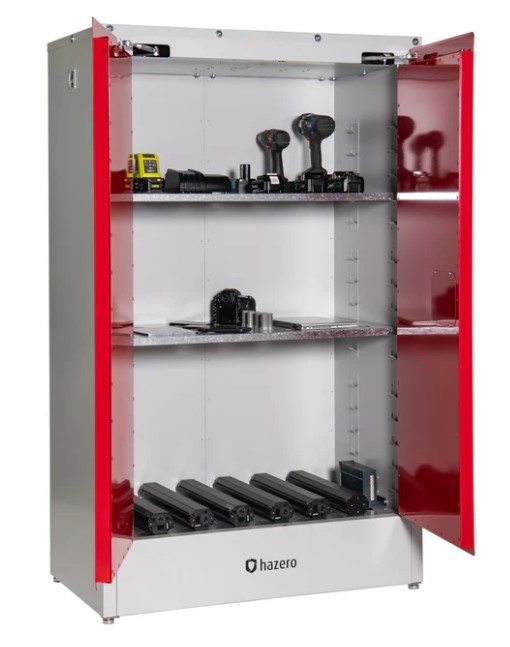
Lithium-ion Batteries have become part of every day life for many of us. They power everything we now take for granted, from our mobile phones to escooters and even our cars.
The flammable electrolyte fluid inside these batteries can become a real hazard if they are damaged, faulty of overcharged.
Lithium-ion battery fires can spread extremely fast and the gases and smoke they produce is highly toxic..
The Hazero Lithium-ion Safety Cabinets now available in Australia through Industroquip help keep batteries isolated and safe - providing time to clear the building and call 000 before lives are at serious risk, if the worst happens. That’s a big step-up from hoping for the best.
Here is a review from Tools & Stuff on the Hazero Lithium-ion Battery Safety Cabinet.
In NSW alone there there was a 66 per cent increase in battery-related fires over the past year, according to Fire and Rescue NSW Deputy Commissioner Paul McGuiggan (Source ABC News article)
The Facts
- Energy Density: Lithium-ion batteries offer a high energy density, packing more energy into a lighter, smaller package compared to traditional batteries. This makes them well-suited to portable tools, devices and e-mobility; like e-scooters and e-bikes.
- Rechargeability: These batteries can be recharged numerous times without suffering from the ‘memory effect’, which is where traditional batteries lose their maximum capacity over time.
- Versatility: The batteries’ versatility allows for various shapes and sizes, making them adaptable to different devices and requirements.
- Widespread use: Their popularity stems from being the primary choice for portable electronics, power tools, and the increasing use of electric mobility.
The Dangers
- Thermal Runaway: Lithium-ion batteries are prone to a phenomenon known as thermal runaway. This is where one faulty cell, or an internal reaction, can rapidly spread across other cells, leading to increased temperatures and potentially causing the battery to explode.
- Damage & mishandling: Physical damage, manufacturing defects, or improper charging can trigger internal shorts, accelerating the risk of thermal runaway.
- Environmental impact: Improper disposal or recycling of Lithium-ion batteries can harm the environment due to the toxic chemicals and metals they contain.
Risk mitigation & safety
The impacts of Lithium-ion battery fires are affecting New Zealand businesses and individuals on an increasingly regular basis.
However, there are steps you can take today reduce and potentially manage those risks:
- Isolation & containment: When storing multiple batteries, store them in a separate area. This will ensure they are isolated from external risks e.g. heat sources. This also works in reverse, containing the impact of a burning battery for as long as possible.
- Temperature control: Storing Lithium-ion batteries at moderate temperatures (around 15-25ºC) helps maintain their stability. Extreme heat can affect the battery’s performance and longevity, to the point where it can catch fire and explode.
- Avoiding physical damage: Store batteries in a way that prevents physical damage and compression, as this can compromise battery integrity and potentially lead to short circuits.
- Partial discharge: If storing batteries for an extended period of time, it’s a good idea to partially discharge them to around 50% capacity first. Storing a battery at full charge for an extended period of time can degrade it’s capacity.
Summary
Lithium-ion batteries will undoubtably play a significant role in our modern workplaces and lifestyles for some time into the future. But understanding their potential risks is vital.
Through increasing risk awareness and implementing safe storage practices, individuals and companies can quickly and effectively mitigate risks, and create safer working environments where Lithium-ion batteries are in use.

Reach out to our team today to discuss our growing range of Lithium-ion Battery Safety Cabinets and Fire Extinguishers on 1300554192 or sales@industroquip.com.au

Leave a Comment